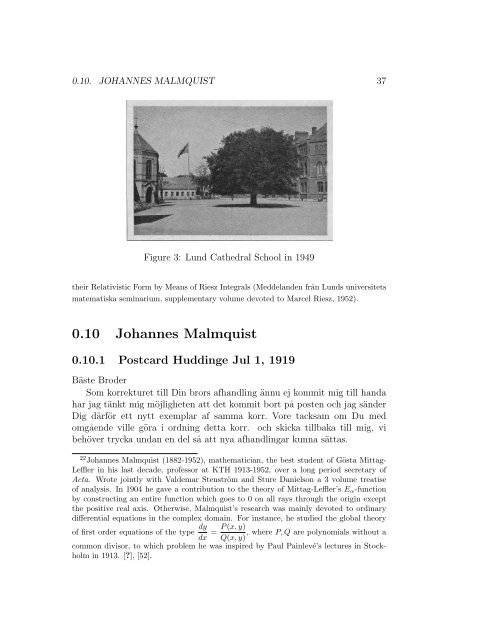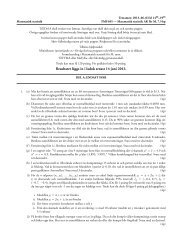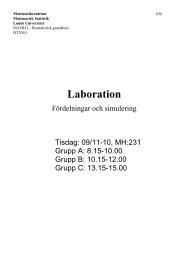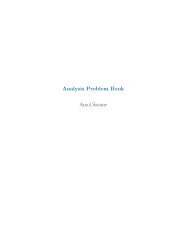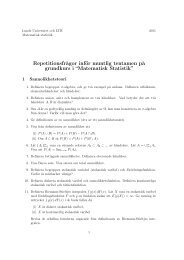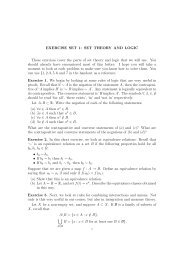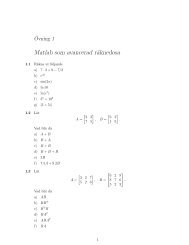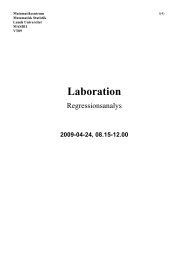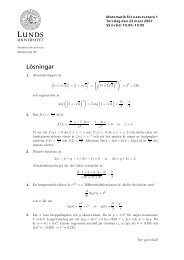- Page 1: Correspondence of Marcel Riesz with
- Page 4 and 5: 4 CONTENTS 0.9.4 Extract from the A
- Page 6 and 7: 6 CONTENTS 0.32.1 Letter Lund Jul 1
- Page 8 and 9: 8 CONTENTS 1.13.1 To Hilma Jusander
- Page 10 and 11: 10 CONTENTS 0.2 Nils Juringius and
- Page 12 and 13: 12 CONTENTS lyckas med en undersök
- Page 14 and 15: 14 CONTENTS 0.2.5 Letter Stockholm
- Page 16 and 17: 16 CONTENTS 0.2.6 Letter Bromma Nov
- Page 18 and 19: 18 CONTENTS Figure 1: Wolfgang Paul
- Page 20 and 21: 20 CONTENTS Translation: My Dear br
- Page 22 and 23: 22 CONTENTS så sätt att jag utgic
- Page 24 and 25: 24 CONTENTS Dear Professor Bohr, Pl
- Page 26 and 27: 26 CONTENTS With hearty greetings a
- Page 28 and 29: 28 CONTENTS kunde få en fullmakt f
- Page 30 and 31: 30 CONTENTS Mina hjärtligaste häl
- Page 32 and 33: 32 CONTENTS U.B. innan Westberg res
- Page 34 and 35: 34 CONTENTS Figure 2: Facsimile of
- Page 38 and 39: 38 CONTENTS Tillgifne vännen J. Ma
- Page 40 and 41: 40 CONTENTS Figure 4: att ✷A = 0,
- Page 42 and 43: 42 CONTENTS one, on the other hand/
- Page 44 and 45: 44 CONTENTS 0.13.1 Card postal stam
- Page 46 and 47: 46 CONTENTS Very truly Yours Erik N
- Page 48 and 49: 48 CONTENTS problem för viskös v
- Page 50 and 51: 50 CONTENTS Here we have for sure s
- Page 52 and 53: 52 CONTENTS Figure 7: Facsimile of
- Page 54 and 55: 54 CONTENTS 0.18 Elisabet Olbers 0.
- Page 56 and 57: 56 CONTENTS För några dagar sedan
- Page 58 and 59: 58 CONTENTS Hilbert så var det mej
- Page 60 and 61: 60 CONTENTS i Uppsala, som inte sku
- Page 62 and 63: 62 CONTENTS unfortunate attempt was
- Page 64 and 65: 64 CONTENTS När du sålunda genoml
- Page 66 and 67: 66 CONTENTS Figure 11: Youthful Åk
- Page 68 and 69: 68 CONTENTS 0.24.1 Letter from Sonj
- Page 70 and 71: 70 CONTENTS 0.24.5 Letter to Åke
- Page 72 and 73: 72 CONTENTS Later we heard that Rie
- Page 74 and 75: 74 CONTENTS själv uppträtt mest.
- Page 76 and 77: 76 CONTENTS function k is allowed t
- Page 78 and 79: 78 CONTENTS Vi ha också betraktat
- Page 80 and 81: 80 CONTENTS academic year. For the
- Page 82 and 83: 82 CONTENTS Leffler-frågan. Det vo
- Page 84 and 85: 84 CONTENTS Elfving, som är mina m
- Page 86 and 87:
86 CONTENTS San Fransisco. If the l
- Page 88 and 89:
88 CONTENTS saker så det har varit
- Page 90 and 91:
90 CONTENTS Chow called, now to tel
- Page 92 and 93:
92 CONTENTS 0.24.18 Letter to Åke
- Page 94 and 95:
94 CONTENTS . . . on my initiative.
- Page 96 and 97:
96 CONTENTS Odhnoff och jag slitit
- Page 98 and 99:
98 CONTENTS in the beginning of Jun
- Page 100 and 101:
100 CONTENTS 0.24.22 Letter May 5,
- Page 102 and 103:
102 CONTENTS skulle Du inte kunna s
- Page 104 and 105:
104 CONTENTS 0.25 Johan Prawitz 0.2
- Page 106 and 107:
106 CONTENTS Please, give regads to
- Page 108 and 109:
108 CONTENTS 0.29 Agathe von Rosen
- Page 110 and 111:
110 CONTENTS For she was so very si
- Page 112 and 113:
112 CONTENTS • 2S 3 − 2(S 1 + S
- Page 114 and 115:
114 CONTENTS haft att ordna det 25-
- Page 116 and 117:
116 CONTENTS in Nässjö. The mothe
- Page 118 and 119:
118 CONTENTS Broder! Det var mycket
- Page 120 and 121:
120 CONTENTS Claes-Gösta Runquist
- Page 122 and 123:
122 CONTENTS retire this year, and
- Page 124 and 125:
124 CONTENTS Min far var telegrafit
- Page 126 and 127:
126 CONTENTS / har inte skett. Det
- Page 128 and 129:
128 CONTENTS to use them himself, a
- Page 130 and 131:
130 CONTENTS also two sons that are
- Page 132 and 133:
132 CONTENTS this is connected with
- Page 134 and 135:
134 CONTENTS Figure 16: Postcard by
- Page 136 and 137:
136 CONTENTS 0.32.2 Letter to Ravin
- Page 138 and 139:
138 CONTENTS 0.34 Erik Stridsberg 0
- Page 140 and 141:
140 CONTENTS Translation: A hearty
- Page 142 and 143:
142 CONTENTS lic. Gårdings utredni
- Page 144 and 145:
144 CONTENTS Beviset för att i β
- Page 146 and 147:
146 CONTENTS där E är energin. I
- Page 148 and 149:
148 CONTENTS Dear Brother, Accordin
- Page 150 and 151:
150 CONTENTS In the usual presentat
- Page 152 and 153:
152 CONTENTS willingly as I, during
- Page 154 and 155:
154 CONTENTS Faithfully yours J. A.
- Page 156 and 157:
156 CONTENTS dx 1 , x 2 , . . . dx
- Page 158 and 159:
158 CONTENTS Alltså är max Rf(z 1
- Page 160 and 161:
160 CONTENTS Tillämpa vi detta på
- Page 162 and 163:
162 CONTENTS for arbitrary complex
- Page 164 and 165:
164 CONTENTS 2. Av ovanstående fra
- Page 166 and 167:
166 CONTENTS Din tillgivne vän Olo
- Page 168 and 169:
168 CONTENTS teater. Sedan börjar
- Page 170 and 171:
170 CONTENTS tanken, att Du inte sk
- Page 172 and 173:
172 CONTENTS pants for you, you had
- Page 174 and 175:
174 CONTENTS Figure 17: Rolf Nevanl
- Page 176 and 177:
176 CONTENTS i ) f(zs l i i ) = (P
- Page 178 and 179:
178 CONTENTS I have then shown that
- Page 180 and 181:
180 CONTENTS 0.41.2 Letter Linköpi
- Page 182 and 183:
182 CONTENTS In view of the manner
- Page 184 and 185:
184 CONTENTS Regretfully I had to s
- Page 186 and 187:
186 CONTENTS som Du förelade mig i
- Page 188 and 189:
188 CONTENTS 0.44.3 Letter Mar 15,
- Page 190 and 191:
190 CONTENTS x = 1 2 . För φ(x) =
- Page 192 and 193:
192 CONTENTS där a är ändlig ell
- Page 194 and 195:
194 CONTENTS 0.46 Herbert Wikmanis
- Page 196 and 197:
196 CONTENTS mich ist, habe ich ein
- Page 198 and 199:
198 CONTENTS 0.48 Sven Wennberg 0.4
- Page 200 and 201:
200 CONTENTS Folke Hagström Transl
- Page 202 and 203:
202 CONTENTS icke motstå frestelse
- Page 204 and 205:
204 CONTENTS 2. This proof presuppo
- Page 206 and 207:
206 CHAPTER 1. LETTERS FROM MARCEL
- Page 208 and 209:
208 CHAPTER 1. LETTERS FROM MARCEL
- Page 210 and 211:
210 CHAPTER 1. LETTERS FROM MARCEL
- Page 212 and 213:
212 CHAPTER 1. LETTERS FROM MARCEL
- Page 214 and 215:
214 CHAPTER 1. LETTERS FROM MARCEL
- Page 216 and 217:
216 CHAPTER 1. LETTERS FROM MARCEL
- Page 218 and 219:
218 CHAPTER 1. LETTERS FROM MARCEL
- Page 220 and 221:
220 CHAPTER 1. LETTERS FROM MARCEL
- Page 222 and 223:
222 CHAPTER 1. LETTERS FROM MARCEL
- Page 224 and 225:
224 CHAPTER 1. LETTERS FROM MARCEL
- Page 226 and 227:
226 CHAPTER 1. LETTERS FROM MARCEL
- Page 228 and 229:
228 CHAPTER 1. LETTERS FROM MARCEL
- Page 230 and 231:
230 CHAPTER 1. LETTERS FROM MARCEL
- Page 232 and 233:
232 CHAPTER 1. LETTERS FROM MARCEL
- Page 234 and 235:
234 CHAPTER 1. LETTERS FROM MARCEL
- Page 236 and 237:
236 CHAPTER 1. LETTERS FROM MARCEL
- Page 238 and 239:
238 CHAPTER 1. LETTERS FROM MARCEL
- Page 240 and 241:
240 CHAPTER 1. LETTERS FROM MARCEL
- Page 242 and 243:
242 CHAPTER 1. LETTERS FROM MARCEL
- Page 244 and 245:
244 BIBLIOGRAPHY [10] Curt Ragnar B
- Page 246 and 247:
246 BIBLIOGRAPHY [33] Karl Dickman:
- Page 248 and 249:
248 BIBLIOGRAPHY [55] Harald Gepper
- Page 250 and 251:
250 BIBLIOGRAPHY [82] Hopf: Die Rel
- Page 252 and 253:
252 BIBLIOGRAPHY [108] Ülo Lumiste
- Page 254 and 255:
254 BIBLIOGRAPHY [134] Henrik Petri
- Page 256 and 257:
256 BIBLIOGRAPHY [156] Carl Ludwig
- Page 258 and 259:
Index Ásgeirsson, Leifur, 85 AAker
- Page 260 and 261:
260 INDEX Euler, 215 Euler, Leonard
- Page 262 and 263:
262 INDEX Langer, Susanne K., 61 La
- Page 264 and 265:
264 INDEX Pleijel. AAke, 64 Pleijel
- Page 266:
266 INDEX Würzburg, 205 Wachtmeist


